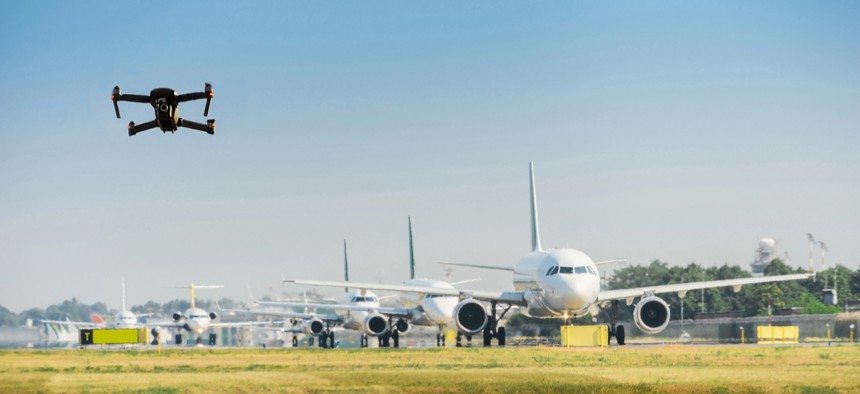Proposed FAA Rule Would Kickstart New Economy For IDing Drones

Alexandre Rotenberg/Shutterstock.com
The new remote ID rule would require all unmanned aircraft systems to have a unique identifier that can be tracked by the FAA, law enforcement and the general public.
Wary of a future in which the skies are filled with unregistered, unidentifiable drones, the Federal Aviation Administration will soon publish a proposed rule to require manufacturers to put remote ID tags in all small unmanned aircraft systems.
On Tuesday, the FAA will publish its proposed rule for remote identification of UAS, starting the process for developing an entire ecosystem over the next three years around identifying drones in flight.
To date, nearly 1.5 million small drones—between 0.55 pounds and 55 pounds—have been registered with the FAA, along with some 155,000 UAS pilots. However, drone pilots currently cannot fly except in specific, restricted areas, mostly managed through partnerships with the FAA’s Low Altitude Authorization and Notification Capability, or LAANC. As the use of drones expands, the FAA wants to ensure air traffic controllers, law enforcement and the general public can easily identify the machines flying overhead.
“As a pilot, my eye is always on safety first,” FAA Administrator Steve Dickson said in a statement Thursday announcing the rule. “Safety is a joint responsibility between government, pilots, the drone community, the general public and many others who make our nation so creative and innovative.”
The rule would identify drones using three methods. The first is the “standard remote identification,” in which the drone broadcasts a unique ID through a radio signal that can be intercepted by air traffic control, law enforcement and even the general public. That ID would also be transmitted to a Remote ID UAS Service Supplier, or Remote ID USS—more on them later—over the internet.
The second method, “limited remote identification,” would only transmit the ID over an internet connection, however, it requires the drone pilot to be within the line of sight of the UAS—no more than 400 feet.
The FAA is also proposing a third scenario where community-based safety organizations can apply to create FAA-recognized identification areas, or FRIAs, where remote IDs are not required for each individual unit but drones are not allowed to fly outside the designated area. This category would only be available for amateur-built drones and UAS built before the remote ID rule was established.
“While remote identification alone will not enable routine expanded operations such as operations over people or beyond visual line of sight, it is a critical element for building unmanned traffic management capabilities,” according to the notice to be published in the Federal Register. “The FAA envisions that the remote identification network will form the foundation for the development of other technologies that can enable expanded operations.”
The remote ID rule is merely the first step in a broader process. FAA officials are also working to establish an ecosystem for Remote ID USS to “collect the identification and location in real-time from in-flight UAS,” and make that data available to the public and law enforcement. Remote ID USS providers will work under contracts with the FAA, similar to the LAANC system for monitoring drone flights.
The third pillar of the remote ID effort will be to establish a standards-setting community to ensure that production of the ID technology and data structure and dissemination methods are the same for all drones produced in the United States.
“This proposal envisions that within three years of the effective date of this rule, all UAS operating in the airspace of the United States will be compliant with the remote identification requirements,” the rule states. “No UAS could be produced for operation in the United States after two years and no UAS could be operated after three years except in accordance with the requirements of this proposal.”
The proposed rule is open for public comment for 60 days.
NEXT STORY: Has the Rise of Uber Led to More Heavy Drinking?




